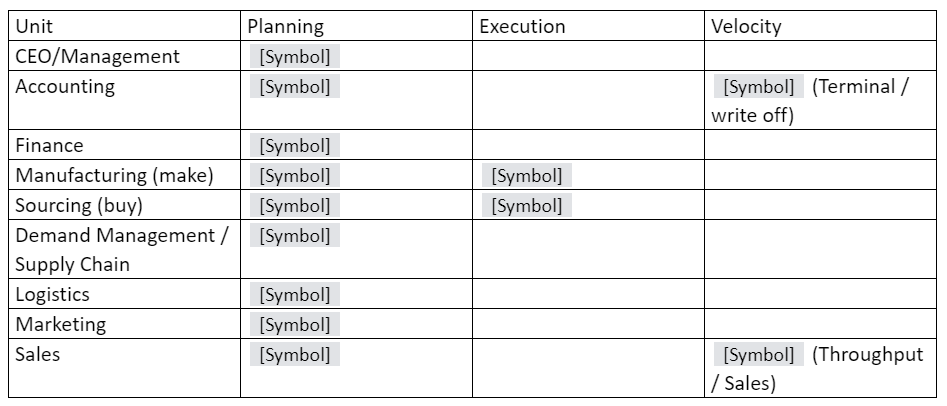Who should take ownership of the demand management process within the organization? Is it Sales and Marketing?
Way back when, in the ‘80s, supply chain started growing its roots. The leading consultants of the time evangelized Materials Resource Planning (MRP), and rightly so. However, most of them decided a Master Scheduler could do it all.
WRONG!
Well, maybe so if you sold a road bike and a mountain bike out of one warehouse in the USA. They did not factor in multiple warehouses in multiple countries with thousands of SKUs. This would overload any mere mortal, let alone a Master Scheduler.
Enter Andre Martin, who faced the reality of shipping multiple SKUs out of multiple warehouses to multiple countries and created a demand driven inventory plan for each one. He labeled his creation DRP (Distribution Requirements Planning) which later expanded to Distribution Resources Planning.
So here I found myself in my little corner of DuPont, becoming a Materials Management Specialist to forecast, plan inventory, and create replenishment plans at multiple warehouses across the United States for over 800 SKUs in three separate businesses.
Oh, what luck…a “to die for experience” encompassing the core of what would later become known as Demand Management. And to top it off, in the mid ‘80s, management placed us in the netherworld of Distribution, neither Sales and Marketing nor Manufacturing.
Where Does Demand Management Belong?
So where does Demand Management belong today, some 30 years later? Assuming the organization sells product to customers through Sales & Marketing, made by Operations, and governed through higher levels of management and holds these truths to be self-evident:
- Finished product is an asset for Sales & Marketing and they hold responsibility for finished product inventory
- Operations controls the manufacture of a finished product
- Demand Management executes the forecast with marketing intelligence from Sales & Marketing
- Demand Management and Operations meet weekly to agree on a deployment plan
- Demand Management hosts the monthly S&OP meeting with Leadership and prepares data for the agreed upon demand plan
Read more: Who Should Take Ownership of Finished Product Inventory Management?
The key to where Demand Management belongs lies in the ownership of a finished product inventory. The most compelling argument for Sales & Marketing owning the finished product inventory lies in the concept of throughput. If you agree that the result of the business is to satisfy the customer with a sale, then one must fondly acquiesce that Sales does the job to convert inventory to revenue. It’s this conversion to revenue that gives material its velocity.
See the following table for the details:
Table I. Finished Product Activity leading to Material Velocity

It would seem natural that Demand Management works with Sales & Marketing to:
- Supervise Customer Service to satisfy customer demand at a tactical level with routine sales activity as well as times of phase-ins and phase-outs, allocation, and abnormal demand
- Select safety stocks at finished product warehouses to buffer demand variability as well as create replenishment plans with replenishment type, lead times, order quantities, and lot sizes, to name a few.
- Mine the data and create analytics for regularly scheduled portfolio analysis and pruning
- Create realistic forecasts at multiple levels using marketing intelligence and provide metrics for improvement. Note: This is at the S&OP level as well as the SKU level that drives inventory replenishment
Read more: Errors in the Planning-Execution System
Lastly, Demand Management needs to meet regularly with Operations and Master Schedulers to ensure the right product is being planned at the right quantity at the right time. Once it’s made the quantity and timing may have changed, so deployment plans need to be altered and agreed upon.
So, back to the question at hand…. where does Demand Management belong?
From Table I., let’s assume Management, Accounting, Finance, Sourcing, and Logistics would rather not be bothered. This leaves us with Manufacturing (Operations), Supply Chain, and Sales & Marketing.
Case I. Manufacturing / Operations
In the beginning of MRP, this is where it landed. It’s a natural choice, since at that time Sales & Marketing could not see why they needed to involve themselves with such nitty gritty detail. Managers at the time were wise to assume the role as Sales & Marketing were vastly unprepared to assume it. On the flip side, this led to high levels of inventory when the reward metrics favored up-time, utilization, yield, and output volume. Why stop the machine when it was running well and producing high yields for which we were highly compensated? In a cost driven world, this is what matters.
Bottom Line: Not a bad place to start, but please move on.
Case II. Supply Chain
With the progression of MRP into DRP and eventually S&OP, the growth of software systems expanded to ever increasing levels of productivity. This led to specialization in the planning field as these essential systems required ever increasing expertise for knowledge workers. Supply Chain harbored these individuals quite nicely, however, they often get dashed upon the rocks of Operations (cost, optimization, and disruption) and washed up on the shores of Sales & Marketing (no product, late product, stock outs, lack of customer knowledge). The difficulty to satisfy both organizations makes for organizational strife. However, with good governance and smart metrics, these problems may become moot.
Bottom Line: This works for many, but only with highly ethical managers willing to deal with both sides.
Case III. Commercial Team (Sales & Marketing)
It takes an organization a while to evolve to this level, but once they understand the need to deliver products and services to the customer in the most efficient manner, Sales & Marketing hold the key to executing this delivery. Knowledge workers may flow between Operations and Demand Management using similar software systems that develop forecasts, plan inventories and execute replenishment plans. This keeps the organization on the focus of the customer if they’ve had a chance to walk in each other’s shoes. Being closest to the customer helps them better execute the business plan without sub-optimization seen in Case I.
Bottom Line: This is where you put your money where your mouth is. Let Sales & Marketing be responsible for what they sell.
Enjoyed this post? Subscribe or follow Arkieva on Linkedin, Twitter, and Facebook for blog updates






